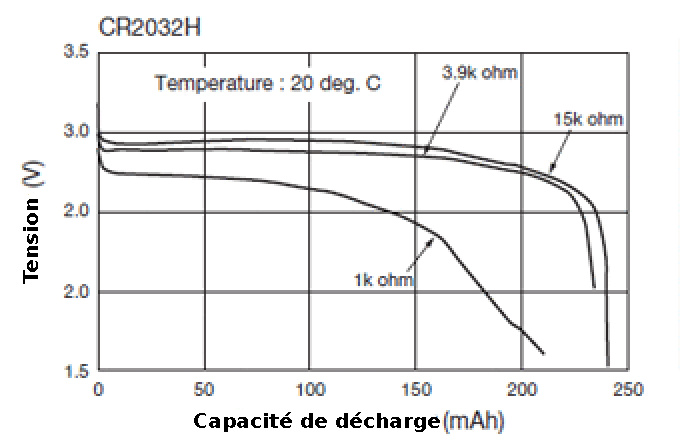Piles-Capacités-et-Aptitudes
Since this is a particularly confusing part of measuring batteries, I'm going to discuss it more in detail.
Power capacity is how much energy is stored in the battery. This power is often expressed in Watt-hours (the symbol Wh). A Watt-hour is the voltage (V) that the battery provides multiplied by how much current (Amps) the battery can provide for some amount of time (generally in hours). Voltage * Amps * hours = Wh. Since voltage is pretty much fixed for a battery type due to its internal chemistry (alkaline, lithium, lead acid, etc), often only the Amps*hour measurement is printed on the side, expressed in Ah or mAh (1000mAh = 1Ah). To get Wh, multiply the Ah by the nominal voltage. For example, lets say we have a 3V nominal battery with 1Amp-hour capacity, therefore it has 3 Wh of capacity. 1 Ah means that in theory we can draw 1 Amp of current for one hour, or 0.1A for 10 hours, or 0.01A (also known as 10 mA) for 100 hours.
However, the amount of current we can really draw (the power capability) from a battery is often limited. For example, a coin cell that is rated for 1 Ah can't actually provide 1 Amp of current for an hour, in fact it cant even provide 0.1 Amp without overextending itself. Its like saying a human has the capability to travel up to 30 miles: of course running 30 miles is a lot different than walking! Likewise, a 1Ah coin cell has no problem providing a 1mA for 1000 hours but if you try to draw 100mA from it, it'll last a lot less than 10 hours.
For example, in this image, a coin cell can drive a 3.9Kohm resistor and provide 230mAh (which is what its rated for) before dropping to 2V, but if its a 1Kohm resistor, it will only provide 125mAh (image from http://biz.maxell.com/en/product_primary/?pci=9&pn=pb0002)
The way the power capability is measured is in C's. A C is the Amp-hour capacity divided by 1 hour. So the C of a 2Ah battery is 2A. The amount of current a battery 'likes' to have drawn from it is measured in C. The higher the C the more current you can draw from the battery without exhausting it prematurely. Lead acid batteries can have very high C values (10C or higher) , and lithium coin cells have very low ones (0.01C)
Tutoriel All About Batteries créé par Lady Ada pour AdaFruit Industries.
Tutoriel traduit par Meurisse D. pour MCHobby.be
Traduit avec l'autorisation d'AdaFruit Industries - Translated with the permission from Adafruit Industries - www.adafruit.com
Toute référence, mention ou extrait de cette traduction doit être explicitement accompagné du texte suivant : « Traduction par MCHobby (www.MCHobby.be) - Vente de kit et composants » avec un lien vers la source (donc cette page) et ce quelque soit le média utilisé.
L'utilisation commercial de la traduction (texte) et/ou réalisation, même partielle, pourrait être soumis à redevance. Dans tous les cas de figures, vous devez également obtenir l'accord du(des) détenteur initial des droits. Celui de MC Hobby s'arrêtant au travail de traduction proprement dit.
